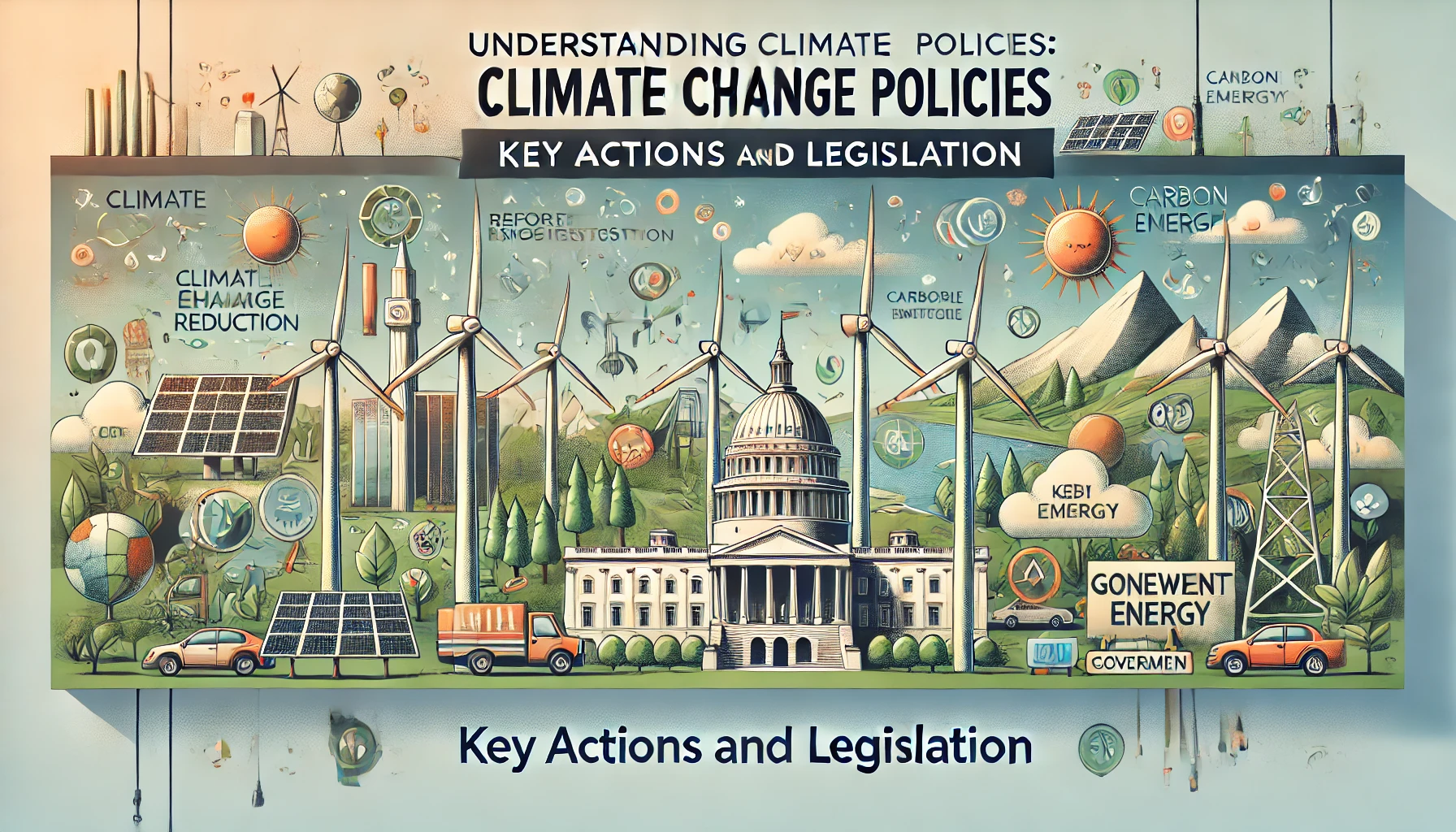Understanding Climate Change Policies: Key Actions and Legislation
- Posted by Emily Brown (United Kingdom)
- Categories General
- Date July 30, 2024
The Importance of Climate Change Policies
Climate change policies are essential for guiding the efforts to reduce greenhouse gas emissions, adapt to the impacts of climate change, and transition to a more sustainable economy. These policies encompass a broad range of measures, including regulations, incentives, and programs aimed at addressing the various aspects of climate change.
Key Aspects of Climate Change Policies
- Global Warming Policy
- Focuses on reducing global temperatures by curbing greenhouse gas emissions.
- Implements measures such as carbon pricing, emissions trading systems, and international agreements like the Paris Agreement.
- Environmental Policy
- Addresses broader environmental issues, including air and water quality, waste management, and biodiversity conservation.
- Integrates climate change considerations into overall environmental protection efforts.
- Climate Change Action
- Encompasses concrete steps taken by governments, businesses, and individuals to combat climate change.
- Includes initiatives like reforestation, energy efficiency programs, and the promotion of sustainable practices.
- Climate Change Legislation
- Involves the creation of laws and regulations that mandate actions to mitigate and adapt to climate change.
- Examples include renewable energy mandates, vehicle emissions standards, and building codes for energy efficiency.
Global Climate Change Policies and Legislation
Governments around the world have implemented various policies and legislation to address climate change. These efforts are crucial for achieving international climate goals and ensuring a coordinated response to the global challenge.
International Agreements and Policies
- Paris Agreement
- A landmark global accord adopted in 2015 to combat climate change and limit global warming to well below 2 degrees Celsius above pre-industrial levels.
- Encourages countries to set nationally determined contributions (NDCs) and regularly update their climate action plans.
- Kyoto Protocol
- An international treaty that commits its parties to reduce greenhouse gas emissions, based on the premise that global warming exists and human-made CO2 emissions have caused it.
- Established legally binding emission reduction targets for developed countries.
- European Green Deal
- An ambitious plan by the European Union to make Europe the first climate-neutral continent by 2050.
- Includes measures to reduce emissions, invest in green technologies, and protect natural habitats.
National Climate Change Policies
- United States
- Rejoined the Paris Agreement in 2021 and committed to reducing emissions by 50-52% below 2005 levels by 2030.
- Implemented policies such as the Clean Power Plan, fuel efficiency standards, and incentives for renewable energy development.
- China
- Announced a goal to achieve carbon neutrality by 2060 and peak carbon emissions before 2030.
- Invests heavily in renewable energy, electric vehicles, and energy efficiency measures.
- India
- Committed to reducing the emissions intensity of its GDP by 33-35% by 2030 from 2005 levels.
- Focuses on expanding renewable energy capacity, enhancing energy efficiency, and promoting sustainable agriculture.
Specific Climate Initiatives and Solutions
Addressing climate change requires targeted initiatives and solutions that tackle specific aspects of the problem. These initiatives often involve collaboration between governments, businesses, and civil society.
Climate Policy 2024
The year 2024 is significant for many countries as they update their climate policies and action plans to meet international commitments. These updates often reflect new scientific findings, technological advancements, and socio-economic changes.
Key Elements of Climate Policy 2024:
- Enhanced NDCs: Countries are expected to submit more ambitious NDCs that outline their plans for reducing emissions and adapting to climate change.
- Sector-Specific Strategies: Focus on critical sectors such as energy, transportation, agriculture, and industry to achieve emission reductions.
- Increased Investment: Mobilizing financial resources for climate action, including public and private sector investments in green technologies and infrastructure.
Climate Change Initiatives
- Renewable Energy Transition
- Promoting the use of renewable energy sources such as solar, wind, and hydroelectric power.
- Implementing policies and incentives to support the development and deployment of renewable energy technologies.
- Energy Efficiency Programs
- Encouraging energy-saving practices in buildings, transportation, and industries.
- Implementing standards and regulations that require improved energy performance.
- Sustainable Transportation
- Promoting the use of electric vehicles, public transportation, and non-motorized transport.
- Implementing policies to reduce emissions from the transportation sector, such as fuel efficiency standards and incentives for clean vehicles.
Climate Change Solutions
Effective climate change solutions require innovative approaches and collaborative efforts. These solutions address both mitigation and adaptation, helping communities reduce their carbon footprint and prepare for the impacts of climate change.
Examples of Climate Change Solutions:
- Carbon Capture and Storage (CCS): Technologies that capture and store CO2 emissions from industrial processes and power plants.
- Climate-Resilient Agriculture: Practices that enhance the resilience of agricultural systems to climate impacts, such as drought-resistant crops and sustainable land management.
- Nature-Based Solutions: Conservation and restoration of natural ecosystems, such as forests and wetlands, to enhance carbon sequestration and provide other environmental benefits.
Carbon Emission Policy and Renewable Energy Policy
Carbon emission policies and renewable energy policies are critical components of climate change mitigation efforts. These policies aim to reduce greenhouse gas emissions and promote the transition to a low-carbon economy.
Carbon Emission Policy
- Carbon Pricing
- Implementing mechanisms such as carbon taxes and emissions trading systems to put a price on carbon emissions.
- Encouraging businesses and consumers to reduce their carbon footprint by making low-carbon choices more cost-effective.
- Emissions Standards
- Setting limits on the amount of greenhouse gases that can be emitted by vehicles, power plants, and industrial facilities.
- Encouraging the adoption of cleaner technologies and practices.
- Carbon Offsetting
- Allowing companies and individuals to offset their emissions by investing in projects that reduce or remove carbon from the atmosphere.
- Examples include reforestation, renewable energy projects, and methane capture.
Renewable Energy Policy
- Renewable Energy Targets
- Setting ambitious targets for the share of energy to be generated from renewable sources.
- Encouraging investment in renewable energy infrastructure and technology development.
- Incentives and Subsidies
- Providing financial incentives such as tax credits, grants, and feed-in tariffs to support the deployment of renewable energy projects.
- Reducing the cost of renewable energy technologies and making them more competitive with fossil fuels.
- Grid Integration
- Enhancing the capacity of electricity grids to integrate and manage variable renewable energy sources.
- Investing in smart grid technologies and energy storage solutions.
Conclusion
Climate change policies play a vital role in guiding global efforts to mitigate and adapt to climate change. From global warming policy and environmental policy to climate change action and legislation, these policies are essential for addressing the complex challenges posed by climate change. Specific initiatives and solutions, such as climate policy 2024, climate change initiatives, climate change solutions, carbon emission policy, and renewable energy policy, provide targeted approaches to reduce emissions and promote sustainability.
As we continue to navigate the impacts of climate change, it is crucial to stay informed and engaged with the latest developments in climate policy and action. For more insights and educational resources, visit Regent Studies. By understanding and supporting effective climate change policies, we can work together to create a more sustainable and resilient future.
In the face of the growing climate crisis, comprehensive climate change policies and initiatives are more important than ever. These efforts not only help reduce greenhouse gas emissions but also promote innovation, economic growth, and social well-being. By staying informed about the latest policies and solutions, we can contribute to the global fight against climate change and ensure a healthier planet for future generations.
You may also like

How to Read Body Language: Mastering the Art of Non-Verbal Communication

Earbuds vs Headphones: Which Is Better for You?


